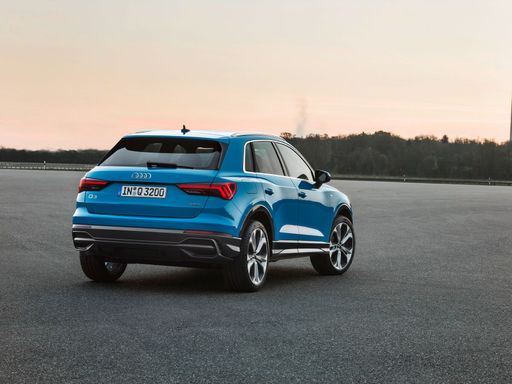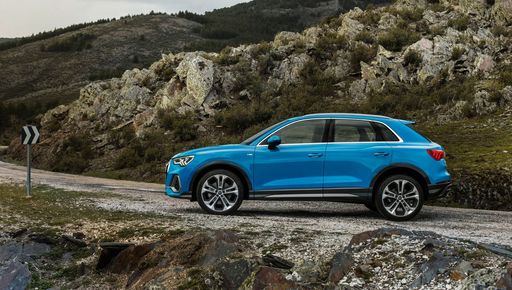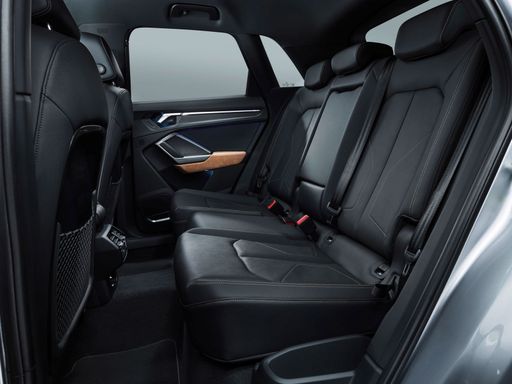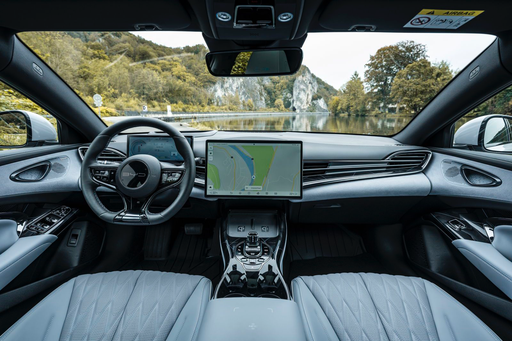Audi Q3 vs BYD Seal – Differences & prices compared
Compare performance, boot space, consumption and price in one view.
Find out now: which car is the better choice for you – Audi Q3 or BYD Seal?
The Audi Q3 (SUV) comes with a Petrol MHEV, Petrol, Plugin Hybrid or Diesel engine and Automatic transmission. In comparison, the BYD Seal (Sedan) features a Electric engine with Automatic transmission.
When it comes to boot capacity, the Audi Q3 offers 488 L, while the BYD Seal provides 400 L – depending on how much space you need. If you’re looking for more power, decide whether the 272 HP of the Audi Q3 or the 530 HP of the BYD Seal suits your needs better.
In terms of consumption, the values are 1.70 L per 100 km for the Audi Q3, and 15.40 kWh for the BYD Seal.
Price-wise, the Audi Q3 starts at 38200 £, while the BYD Seal is available from 40300 £. Compare all the details and find out which model fits your lifestyle best!
Audi Q3
The Audi Q3 seamlessly blends practicality with luxury, making it an ideal choice for urban dwellers and adventure seekers alike. With its striking design and sophisticated interior, the Q3 offers a premium driving experience that caters to both comfort and style. As a compact SUV, it effortlessly navigates through city streets while providing ample space for passengers and cargo.
details @ audi-mediacenter.com
@ audi-mediacenter.com
 @ audi-mediacenter.com
@ audi-mediacenter.com
 @ audi-mediacenter.com
@ audi-mediacenter.com
 @ audi-mediacenter.com
@ audi-mediacenter.com
 @ audi-mediacenter.com
@ audi-mediacenter.com
BYD Seal
The BYD Seal represents a sleek fusion of innovative technology and stylish design, setting it apart in the competitive electric vehicle market. With its aerodynamic silhouette and premium interior finishes, the car offers a driving experience that is both comfortable and exhilarating. Enthusiasts are particularly impressed by the seamless integration of advanced features that prioritise safety and convenience.
details @ press.bydauto.be
@ press.bydauto.be
 @ press.bydauto.be
@ press.bydauto.be
 @ press.bydauto.be
@ press.bydauto.be
 @ press.bydauto.be
@ press.bydauto.be
 @ press.bydauto.be
@ press.bydauto.be

|

|
|
|
|
Costs and Consumption |
|
|---|---|
|
Price
38200 - 52900 £
|
Price
40300 - 43700 £
|
|
Consumption L/100km
1.7 - 8.6 L
|
Consumption L/100km
-
|
|
Consumption kWh/100km
-
|
Consumption kWh/100km
15.4 - 18.2 kWh
|
|
Electric Range
118 - 119 km
|
Electric Range
460 - 570 km
|
|
Battery Capacity
19.70 kWh
|
Battery Capacity
-
|
|
co2
39 - 195 g/km
|
co2
0 g/km
|
|
Fuel tank capacity
45 - 60 L
|
Fuel tank capacity
-
|
Dimensions and Body |
|
|---|---|
|
Body Type
SUV
|
Body Type
Sedan
|
|
Seats
5
|
Seats
5
|
|
Doors
5
|
Doors
4
|
|
Curb weight
1635 - 1900 kg
|
Curb weight
1907 - 2185 kg
|
|
Trunk capacity
375 - 488 L
|
Trunk capacity
400 L
|
|
Length
4531 mm
|
Length
4800 mm
|
|
Width
1859 mm
|
Width
1875 mm
|
|
Height
1559 - 1601 mm
|
Height
1460 mm
|
|
Payload
505 - 535 kg
|
Payload
446 - 473 kg
|
Engine and Performance |
|
|---|---|
|
Engine Type
Petrol MHEV, Petrol, Plugin Hybrid, Diesel
|
Engine Type
Electric
|
|
Transmission
Automatic
|
Transmission
Automatic
|
|
Transmission Detail
Dual-Clutch Automatic
|
Transmission Detail
Reduction Gearbox
|
|
Drive Type
Front-Wheel Drive, All-Wheel Drive
|
Drive Type
Rear-Wheel Drive, All-Wheel Drive
|
|
Power HP
150 - 272 HP
|
Power HP
231 - 530 HP
|
|
Acceleration 0-100km/h
5.7 - 9.2 s
|
Acceleration 0-100km/h
3.8 - 7.5 s
|
|
Max Speed
208 - 240 km/h
|
Max Speed
180 - 220 km/h
|
|
Torque
250 - 400 Nm
|
Torque
360 - 670 Nm
|
|
Number of Cylinders
4
|
Number of Cylinders
-
|
|
Power kW
110 - 200 kW
|
Power kW
170 - 390 kW
|
|
Engine capacity
1498 - 1984 cm3
|
Engine capacity
-
|
General |
|
|---|---|
|
Model Year
2025
|
Model Year
2023 - 2025
|
|
CO2 Efficiency Class
E, G, B
|
CO2 Efficiency Class
A
|
|
Brand
Audi
|
Brand
BYD
|
Audi Q3
The Audi Q3 stands as a prime example of what modern compact SUVs can achieve, combining dynamic performance with cutting-edge technology and refined luxury. This versatile vehicle caters to a diverse audience, offering a range of engine options and innovative features that elevate the driving experience.
Engine Performance and Efficiency
The Audi Q3 impresses with its selection of powertrains, particularly the 2.0-litre turbocharged engines which are available in both petrol and diesel variants. With power outputs ranging from 150 PS to 245 PS, there's a model to suit varying performance needs.
Efficiency is also a highlight, with diesel variants achieving impressive fuel consumption figures as low as 5.5 L/100km. In contrast, petrol options balance power and economy, maintaining competitive consumption levels. Such efficiency is complemented by low CO2 emissions, making the Q3 a smart choice for eco-conscious drivers.
Transmission and Drive Options
Transmission options for the Audi Q3 include both manual and automatic gearboxes, including Audi’s advanced seven-speed S tronic dual-clutch transmission. This allows for swift gear changes and enhances driving dynamics. All-wheel drive is available on select models, providing superior traction and stability, especially in adverse weather conditions.
Technological Innovations
Stepping inside the Audi Q3 reveals a meticulously designed cabin outfitted with the latest technology. The Virtual Cockpit, a fully digital driver display, allows for extensive customisation of vehicle information. The infotainment system also integrates seamlessly with smartphone applications through Apple CarPlay and Android Auto, ensuring connectivity on the go.
Moreover, safety features like adaptive cruise control, lane assist, and a 360-degree camera add a layer of confidence for the driver, making every journey more secure.
Comfort and Space
Space is a defining characteristic of the Q3, which comfortably seats five passengers. The vehicle offers a generous boot capacity of 530 litres, making it practical for both daily commutes and weekend adventures. Additionally, the interior design exudes sophistication with premium materials and ambient lighting, creating an inviting atmosphere.
Pricing and Market Position
Starting at competitive pricing within its class, the Audi Q3 offers outstanding value, considering its extensive list of features and luxurious feel. Prices ranging from approximately €38,300 to €52,750 ensure that there's a model suited for various budgets, appealing to both entry-level buyers and those looking for top-tier specifications.
Conclusion
In summary, the Audi Q3 combines performance, technology, and luxury in a compact SUV design. With a variety of engine choices, advanced safety features, and a spacious interior, it caters to the needs of modern drivers. Whether you are navigating city streets or exploring the great outdoors, the Q3 proves to be an exceptional companion on the road.
BYD Seal
The BYD Seal: An Electrifying Presence on the Road
Amidst the growing popularity of electric vehicles (EVs), the BYD Seal stands out as a compelling choice. With its sleek saloon design and a plethora of cutting-edge features, this model holds its own in the competitive market of eco-conscious automobiles.
Technical Specs that Speak Volumes
The BYD Seal comes in two key variants, each offering a distinct driving experience yet retaining a common emphasis on performance and efficiency. The power output ranges from a robust 313 PS to an exhilarating 530 PS, ensuring that whether you choose the rear-wheel drive or the all-wheel-drive option, you won't be short of thrills.
Performance enthusiasts will also appreciate the remarkable acceleration capabilities; the Seal can go from 0 to 100 km/h in as little as 3.8 seconds. Complementing its acceleration is its astounding maximum torque, reaching up to 670 Nm, making it adept at handling various driving conditions.
Efficiency Meets Innovation
BYD has engineered the Seal to optimise energy consumption without compromising on performance. The car boasts a commendable energy consumption range of 16.6 - 18.2 kWh/100km, reflecting its efficiency-focused design. Coupled with an impressive electric range of up to 570 km, the Seal is poised for longer journeys without frequent recharging interruptions.
Design and Comfort
The BYD Seal's aesthetic appeal is underscored by its sleek saloon body and precise dimensions: 4800 mm in length, 1875 mm in width, and standing at a height of 1460 mm. These dimensions create a dynamic yet spacious presence on the road, ensuring both an aerodynamic performance and a comfortable interior for up to five passengers.
Inside, the Seal is designed with driver and passenger comfort in mind, featuring a well-crafted interior and advanced technology to enhance the driving experience. The boot offers 400 litres of space, catering to practical needs without compromising on style.
Innovative Features for a Modern Drive
The Seal doesn’t just rely on its electric credentials to make an impact. BYD integrates a host of modern technologies and safety features, ensuring that the driving experience is both innovative and secure. The inclusion of a single-speed reduction gear contributes to a smooth driving experience, enabling efficient transitions in speed.
Safety is further assured with the Seal's high CO2 efficiency rating of class A, underlining its efficacy as a sustainable mode of transport that does not contribute to emissions. Given these progressive features, it's clear that the BYD Seal aligns with the evolving expectations of modern drivers looking for an eco-friendly yet high-performing vehicle.
Conclusion: Future-Ready Efficiency
With a competitive price range starting from €44,990, the BYD Seal represents excellent value for those seeking a blend of performance, efficiency, and modern technology. As sustainable transportation becomes a priority globally, the Seal positions itself as a pioneering force in the electric vehicle market, offering a future-ready driving solution that can meet the needs of today's discerning car buyers.
Which drive types are available for the Audi Q3?
Available as Front-Wheel Drive or All-Wheel Drive.
The prices and data displayed are estimates based on German list prices and may vary by country. This information is not legally binding.
